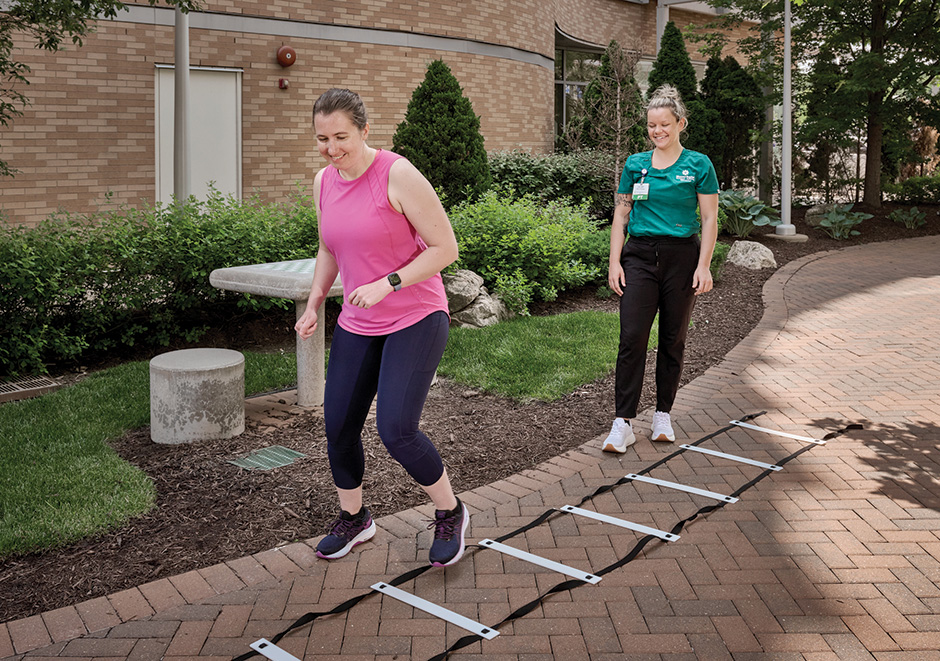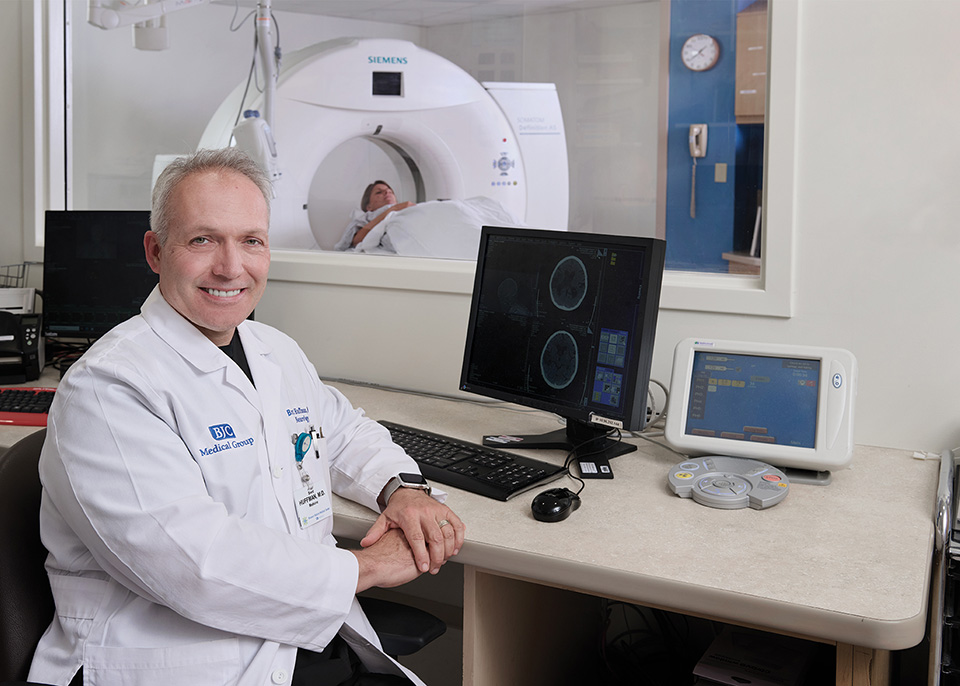MoBap therapy helps Brenda rebuild strength and recover.
 Brenda and physical therapist Elizabeth Worland.
Brenda and physical therapist Elizabeth Worland.
During a shopping trip at a retail store, 36-year-old Brenda Chiu suddenly slurred her words, couldn’t walk straight and felt her left arm and leg go weak. Something was wrong.
“I felt like I had lost control of my body,” Brenda recalls. Her husband, Raymond, also noticed that the left side of her face was drooping. Unsure of what was happening, he helped Brenda to the car and drove immediately to the nearest emergency department.
After emergency department doctors evaluated her, Brenda had a computed tomography (CT) scan of her head to check for signs of a stroke. “The results of the scan did not show any signs of a blood clot, and I was discharged home with ‘unexplained weakness’ and instructions to follow up with a neurologist,” she explains.
The following day, Brenda woke up still not feeling right. “My symptoms seemed worse than the day before,” she says. “Raymond and I drove to Missouri Baptist’s emergency department for a second evaluation.”
The emergency department at MoBap is staffed by Washington University physicians. As a Washington University employee, Brenda knew the high quality of care provided at hospitals across the BJC
HealthCare system.
At MoBap’s emergency department, Brenda was immediately taken to the Stroke Stop station, where a nurse specializing in strokes asked about her symptoms and performed a physical examination and cognitive evaluation to see how her brain was functioning.
Brenda was admitted to MoBap’s neurology floor for further monitoring and testing, including bloodwork to check cholesterol and blood sugar levels, CT scans and a magnetic resonance image (MRI) to determine if — and where — a stroke occurred.
After the tests, BJC Medical Group physician Brent Huffman, MD, a neurologist on staff at MoBap, gave Brenda the results.
Sitting on a chair close to her bed, Dr. Huffman explained that Brenda’s bloodwork was normal, except for a slightly elevated cholesterol level. But the results of the CT scan showed five areas in the right side of her brain that suffered multiple strokes.
Brenda also learned she scored a three on the National Institutes of Health Stroke Scale (NIHSS). The NIHSS scores range from zero to 42, with a minor stroke scoring one to four and a severe stroke scoring 21 to 42.
When a stroke occurs, the blood flow is suddenly stopped or interrupted, and the brain doesn’t receive sufficient oxygen and nutrients. This loss of blood flow can cause brain cells to die, which can lead to
permanent brain injury.
Because of Brenda’s age and health history, Dr. Huffman also ordered other tests to help determine the possible cause of her stroke. Blood work was drawn to test for clotting disorders and autoimmune disease. A sample of Brenda’s cerebral spinal fluid (CSF) was also tested for infection.
“While the results of her clotting and CSF tests were negative, the blood work showed positive results for a possible autoimmune condition,” Dr. Huffman says. To follow up on these findings, Brenda completes additional testing with the MoBap rheumatologist team.
While Brenda was in the hospital recovering, the nursing staff checked for improvements. After a few days, there were small improvements. “One of the first improvements I celebrated was being able to
raise my left arm and hold it in place without it falling right away,” Brenda says.
 Dr. Huffman views Brenda’s CT scan
Dr. Huffman views Brenda’s CT scan
She adds that Dr. Huffman visited every day. “Because they haven’t been able to determine what caused my stroke, I’ve had to deal with some anxiety. But everyone respected how I was feeling, and I felt like my emotions and mental health mattered.”
When Brenda started physical and occupational therapy while she was in the hospital, she couldn’t lift her left foot and dragged it behind her when walking. “Michelle Hodel, my physical therapist, used
kinesio taping to help stabilize my ankle and foot and improve movement and balance.”
“All of my therapists were awesome, and I give them credit for helping me improve so quickly. My stability and balance are close to normal.”
Brenda Chiu
By the end of the first week, Brenda could walk without dragging her foot and was more stable when standing. “Before I was discharged home, I was running with her outside on MoBap’s trail. It felt amazing!”
Occupational therapists also worked with Brenda on improving the strength and coordination of her hand. After two weeks, as Brenda’s face droop disappeared and progress was made during therapy, she
was discharged home. She continues her therapy appointments two days a week at MoBap’s Center for Outpatient Therapy and Wellness.
Reflecting on her experience, Brenda is thankful she came to MoBap for a second evaluation. She advises others about the importance of seeking help. “If you don’t feel right, don’t ignore symptoms and get checked immediately.”
Discover more: Call 314-996-5433 or visit missouribaptist.org/stroke.